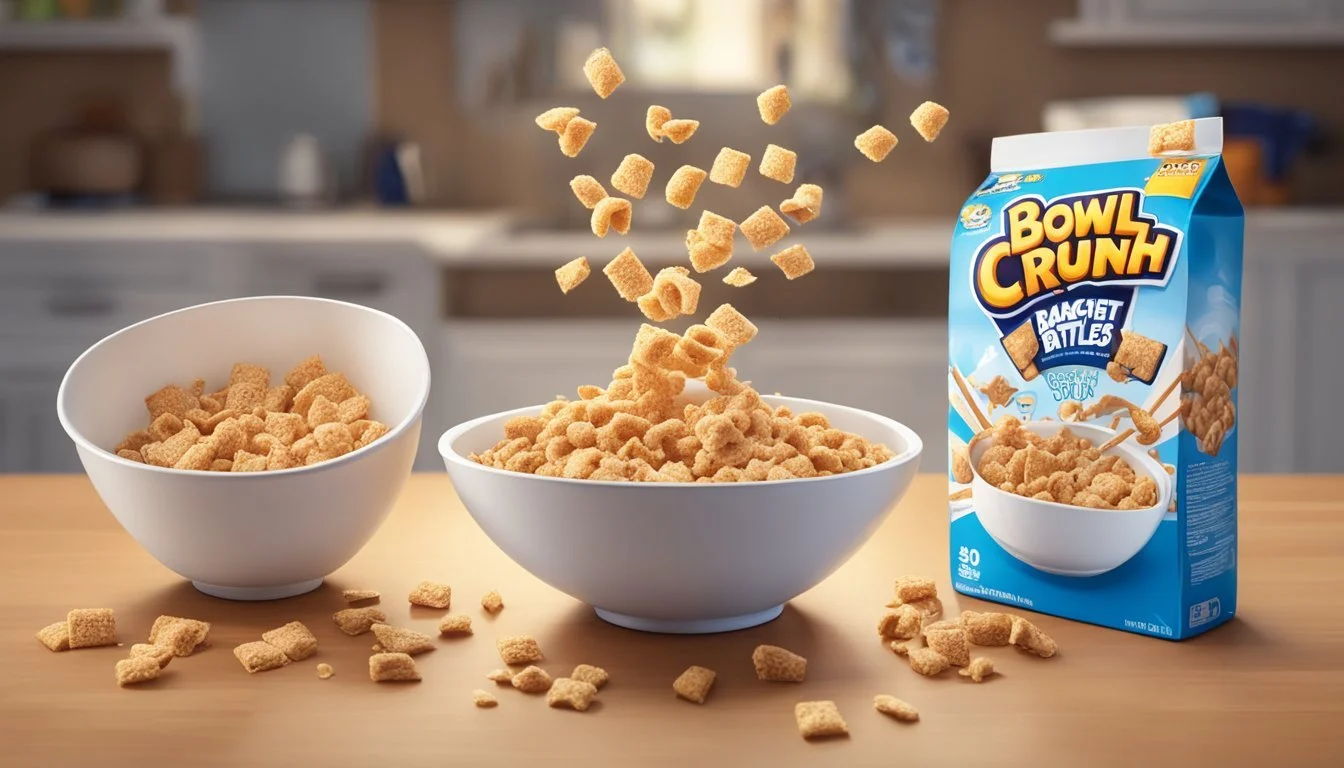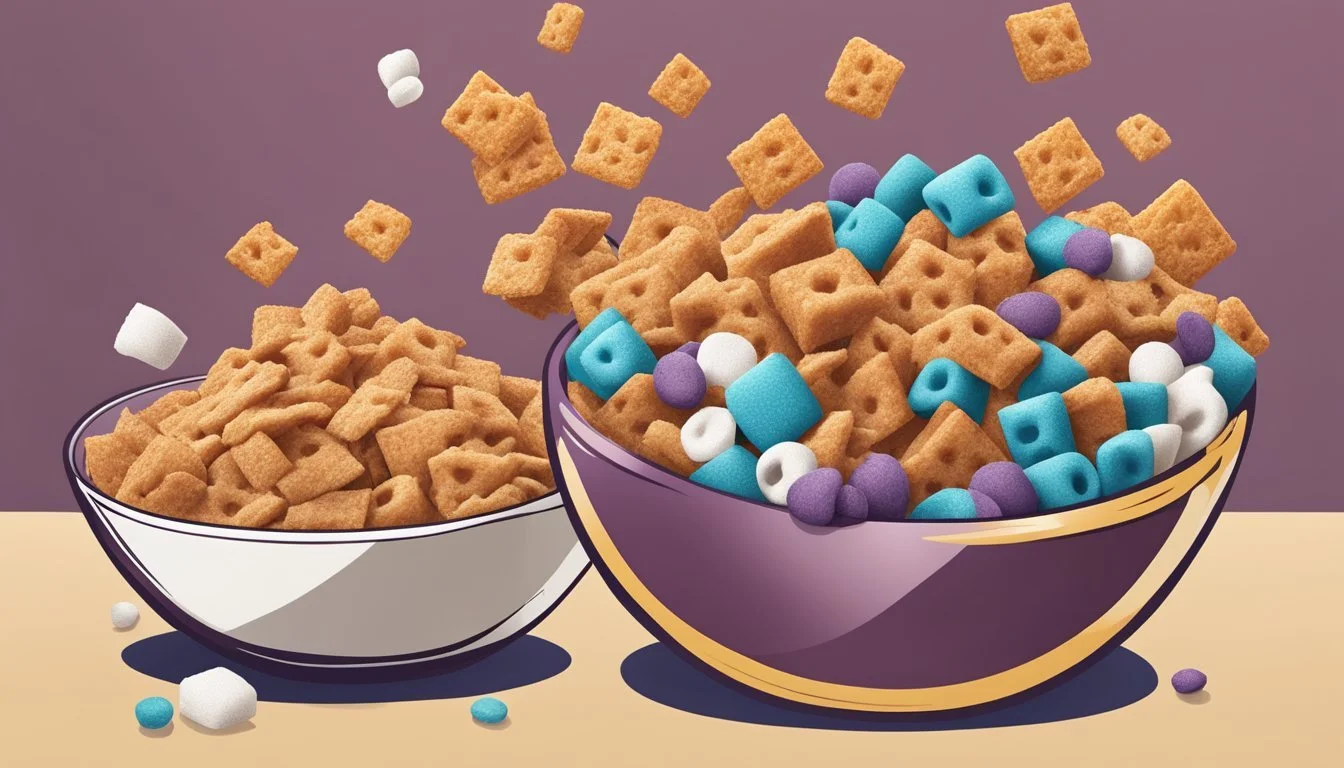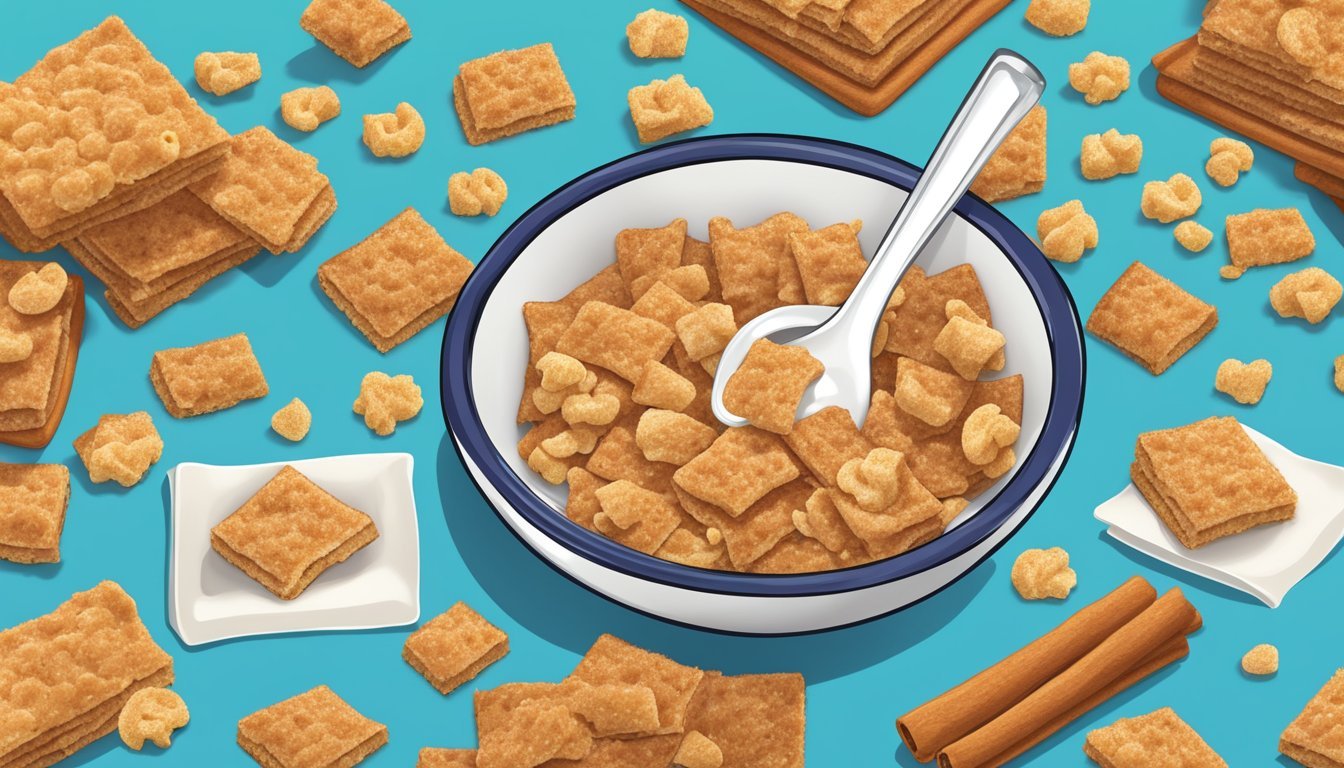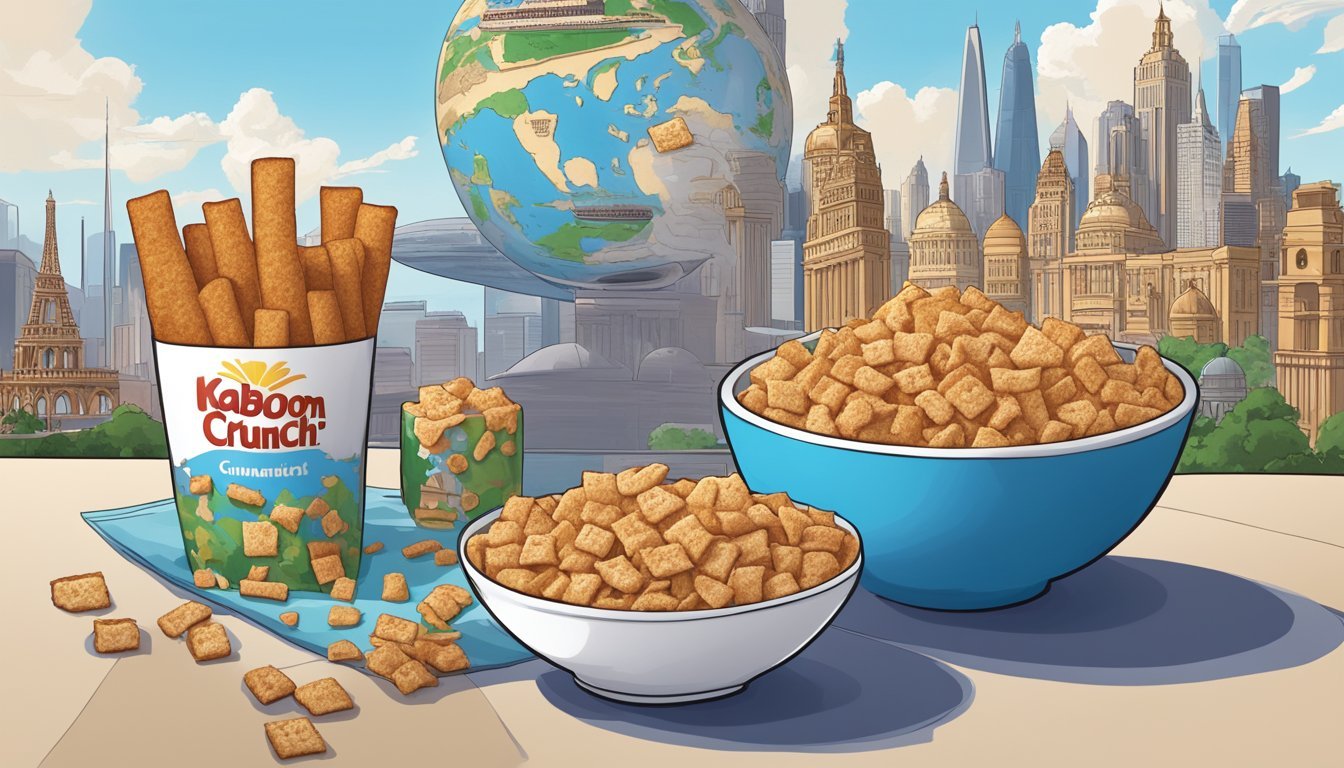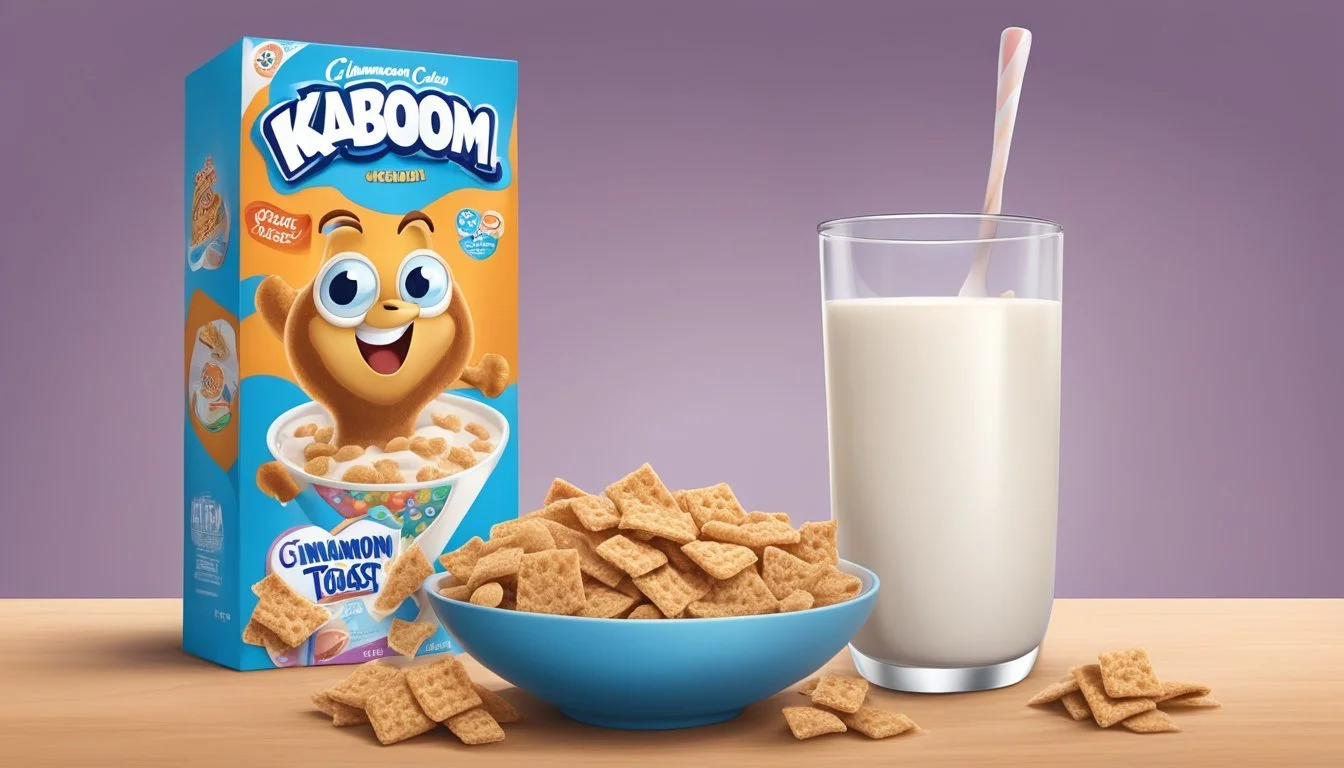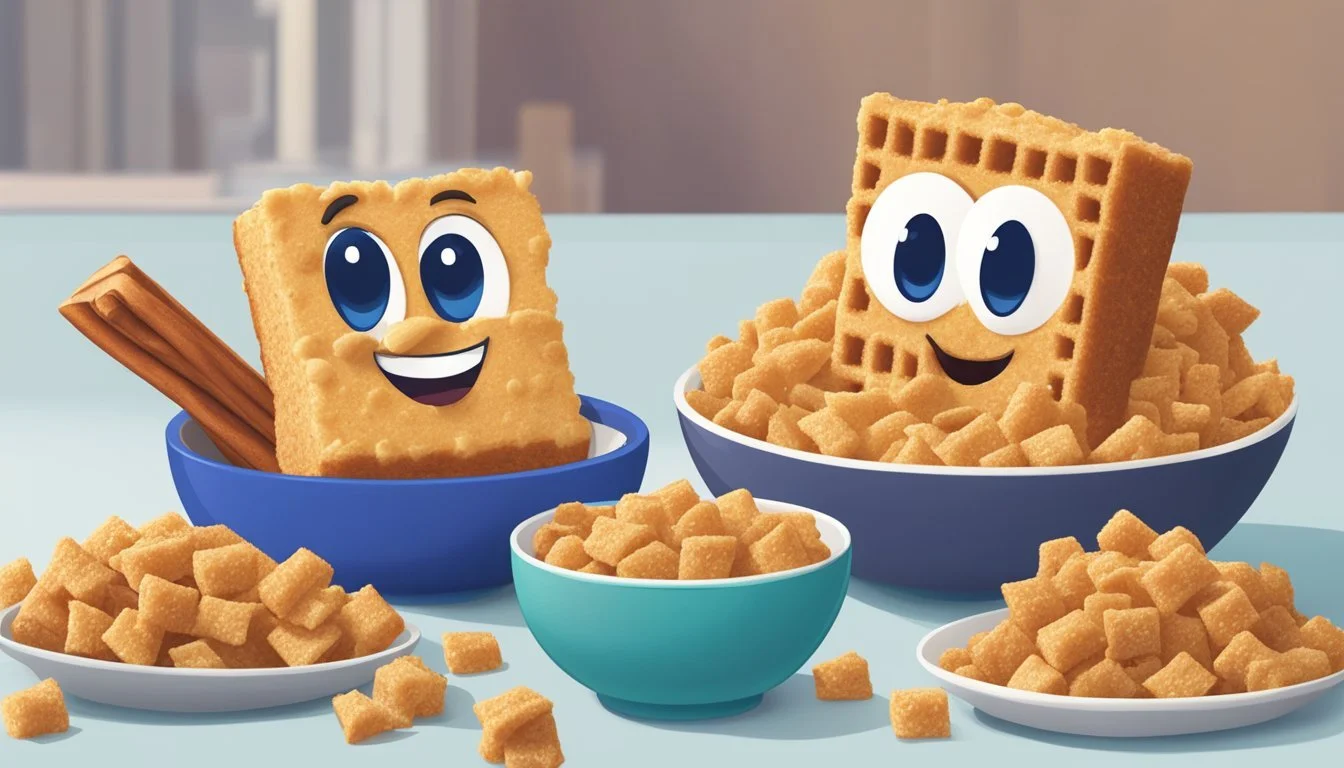Cinnamon Toast Crunch vs Kaboom
Comparing Iconic Cereals
This Article is Part of Our Breakfast Cereal Guide with Details on Cinnamon Toast Crunch Nutrition and Kaboom Nutrition
People often debate which breakfast cereal reigns supreme, and today the spotlight is on Cinnamon Toast Crunch and Kaboom. Both of these cereals have garnered fan followings over the years for distinct reasons.
Cinnamon Toast Crunch is renowned for its delightful mix of cinnamon sugar and crunch. This cereal has maintained its status as a staple in many households since its debut in 1984, mimicking the taste of cinnamon sugar toast with remarkable accuracy. People appreciate its unique flavor profile and the nostalgic feelings it evokes.
Kaboom, on the other hand, brings a fun twist to the breakfast table with its colorful cereal pieces and sweet flavor. Featuring playful shapes and bright colors, Kaboom appeals to children and adults alike. Though perhaps not as widely known as Cinnamon Toast Crunch, Kaboom has a loyal audience who appreciate its cheerful appearance and satisfactory taste.
History and Evolution
Cinnamon Toast Crunch and Kaboom have unique origins in the world of breakfast cereals. Each has its distinct development trajectory, from their initial introduction to the expansion into various flavors.
Origin of Cinnamon Toast Crunch
Cinnamon Toast Crunch debuted in 1984, conceptualized by John Mendesh and Elisabeth Trach at General Mills. This cereal was designed to replicate the taste of buttered cinnamon toast, featuring a mix of cinnamon and sugar with a crunchy texture. Over the years, the packaging and marketing tactics evolved, with Chef Wendell emerging as the cereal's primary mascot in early advertising campaigns. The use of animated Crazy Squares began in 2010 to highlight the cereal's playful and fun nature.
Kaboom's Cereal Legacy
Kaboom cereal, another product from General Mills, was first introduced in 1969. Known for its clown mascot and vibrant colors, it gained popularity among children for its circus-themed marketing and sweet, fruity flavors. Kaboom featured whimsical shapes and was fortified with vitamins, which made it a distinctive choice in the cereals aisle. It, however, experienced fluctuating popularity over the decades and was eventually phased out sometime in the 2010s.
Development of Flavors
Cinnamon Toast Crunch expanded its line with various flavor iterations. Notable spin-offs include French Toast Crunch, which mimicked the taste of French toast and gained a dedicated following. Discontinued in 2006, it returned by popular demand in 2015. Other variants like Chocolate Toast Crunch and Peanut Butter Toast Crunch showcased the versatility of the cinnamon flavor base. These adaptations capitalized on bringing new taste experiences while maintaining the core appeal of the original cereal.
Kaboom did not see as diverse an expansion in flavors as Cinnamon Toast Crunch. Its primary focus remained on the original sweetened, fruity flavor. Despite fewer variations, Kaboom remained notable for its nutritional fortification, making it a memorable part of many childhood breakfasts during its peak years.
Nutritional Comparison
This section breaks down the essential nutritional aspects of Cinnamon Toast Crunch and Kaboom to provide clarity on their respective health benefits and potential drawbacks.
Caloric Content
Cinnamon Toast Crunch contains 168.5 calories per serving, with a notable portion coming from fats. Comparatively, Kaboom offers approximately 150 calories per serving.
In both cereals, sugar constitutes a significant calorie source, but Kaboom has slightly less sugar. The caloric differences can influence dietary choices, especially for those monitoring energy intake.
Vitamins and Minerals
Cinnamon Toast Crunch includes added vitamins and minerals like Vitamin D3 and Vitamin B12. These fortifications can support daily nutritional needs but may not suit strict vegans due to sourcing from animal products.
Kaboom is fortified similarly but emphasizes Vitamin C, iron, and zinc, essential for immune function and overall health. Iron and calcium support bone health, making Kaboom nutritionally competitive.
Whole Grains and Fiber
Cinnamon Toast Crunch provides around 2 grams of fiber per serving, totaling about 5 grams per 100 grams. This fiber content aids digestion but is moderate compared to options like Fiber One.
Kaboom's whole grain content is substantial, reflecting a commitment to heart-healthy ingredients. The fiber in Kaboom helps slow sugar digestion, beneficial for maintaining balanced blood glucose levels.
Protein Sources
Both cereals contain minimal protein, insufficient for a standalone protein source in a meal. Cinnamon Toast Crunch and Kaboom derive their protein primarily from their cereal grains.
Individuals seeking higher protein intake may need additional sources, such as milk or yogurt, complementing the cereals' nutritional profiles.
Taste and Texture Profile
Both Cinnamon Toast Crunch and Kaboom offer distinctive taste and texture experiences that cater to different preferences. While Cinnamon Toast Crunch emphasizes a cinnamon-sugar combination with a notable crunch, Kaboom delivers a mix of flavors and textures that make for an intriguing comparison.
Cinnamon and Sugar Highlights
Cinnamon Toast Crunch stands out with its potent cinnamon-sugar blend, creating an immediately recognizable flavor profile. The cinnamon swirls across each square ensure a consistent taste in every bite. The strong cinnamon-sugar taste is a primary feature, making it a favorite for those who enjoy a sweet, spiced flavor.
Kaboom, on the other hand, provides a more subdued sweetness with hints of cinnamon. The sugar content is noticeable but less intense than in Cinnamon Toast Crunch. The flavor mix in Kaboom leans towards fruit-like notes, contributing to a less uniform taste experience. This cereal targets those who prefer a more diverse yet still sweet flavor in their cereal bowl.
Cereal Texture Contrast
The texture of Cinnamon Toast Crunch is among its defining characteristics. Made from a mix of rice and wheat, the cereal delivers a crisp crunch that stays relatively firm even after it sits in milk for a while. The crazy squares shape helps maintain its texture, providing a satisfying bite that cereal enthusiasts appreciate.
Kaboom, being aimed more towards children, features a lighter and more airy texture. It is softer and tends to soak up milk faster, which can lead to a quicker loss of crunchiness. This difference in texture might appeal to younger children who prefer a less robust crunch in their breakfast cereal.
Milk Interaction
Cinnamon Toast Crunch interacts with milk in a way that enhances both flavor and texture. The cinnamon and sugar dissolves into the milk, creating a sweet, spiced milk that is often a highlight for many. The cereal holds its shape well, maintaining a satisfying crunch even after soaking.
Kaboom's interaction with milk is somewhat different. The pieces absorb milk more quickly due to their airy structure, softening faster than Cinnamon Toast Crunch. This can be a downside for those who enjoy keeping a crunchy texture throughout their meal. Nevertheless, the resulting milk mixture can have a unique, subtly sweet taste due to the cereal's varied flavors.
In summary, while both cereals offer unique and enjoyable experiences, the specific highlights of sweetness, texture, and milk interaction may sway preferences depending on what one seeks in their morning bowl.
Cereal Variations and Related Products
There are many variations of cereals, offering a mix of flavors and ingredients tailored to different preferences. Cinnamon Toast Crunch and Kaboom present a range of products that highlight the diversity within their lines.
Extended Cinnamon Toast Crunch Family
Cinnamon Toast Crunch has expanded its product line beyond the original cereal. Some notable variations include Cinnamon Toast Crunch Churros, which mimics the shape and flavor of churros with a robust cinnamon and sugar coating.
Sugar Cookie Toast Crunch brings the festive taste of sugar cookies into breakfast form. Apple Cinnamon Toast Crunch combines the sweetness of apples with the spice of cinnamon, providing a fruity twist. These cereals maintain the signature crunch and real cinnamon swirls that the original is known for, ensuring consistent texture and taste.
Kaboom's Product Line
Kaboom, a vintage cereal cherished for its colorful, circus-themed shapes and marshmallows, has maintained a loyal fanbase over the years. Though not as extensive as Cinnamon Toast Crunch's family, Kaboom offers variations that have held their charm.
The primary version of Kaboom cereal is noted for its fortification with vitamins and iron, making it a nutritious choice for breakfast. The bright colors and playful shapes appeal to children, while the marshmallow bits add sweetness to the mix. The cereal's wheat and corn base provides a distinct texture that differs from the pure cinnamon focus of its rival.
Marketing and Advertisements
Cinnamon Toast Crunch and Kaboom employ distinct marketing strategies to capture their audiences. Both cereals utilize unique mascots and themes, specialized advertising campaigns, and various promotional efforts to engage consumers.
Character Mascots and Themes
Cinnamon Toast Crunch's mascot is Chef Wendell, who has become iconic over the years. His character is often featured in commercials emphasizing the cereal's sweet cinnamon flavor. The brand also uses animated cinnamon squares that "come alive," which appeal to younger audiences with their playful antics.
Kaboom cereal features a clown mascot named Kaboom, characterized by vibrant colors and circus-themed imagery. This approach is designed to attract children through a fun and whimsical presentation, making breakfast an entertaining experience.
Advertising Campaigns and Strategies
Cinnamon Toast Crunch invests heavily in diverse advertising formats, including TV, digital, and print. Annual spending often exceeds $20 million. The brand leverages memorable slogans like "The taste you can see" to highlight its unique cinnamon sugar coating.
Recent campaigns have included "selfie spoon" promotions and social media engagements. These strategies emphasize interaction and viral potential, reinforcing the brand's appeal among tech-savvy youth.
Kaboom, in contrast, has a more modest advertising presence. The cereal's campaigns are less frequent, focusing mainly on traditional TV spots and print ads. Their strategy often involves emphasizing the playful and colorful aspects of the product, appealing to both nostalgic parents and new young consumers.
Promotions and Media Tie-Ins
Cinnamon Toast Crunch has engaged in several high-profile promotions. One notable example is the "selfie spoon" campaign, where consumers could get a spoon with a built-in camera. This initiative garnered significant social media buzz and helped boost brand engagement.
The brand also capitalizes on limited-edition products and seasonal variations, like "Cinnadust," which extends its flavor profile into other food categories.
Kaboom cereal has fewer promotions but occasionally features special offers in collaboration with children's media. These tie-ins with popular TV shows or movies create additional incentives for purchase and strengthen the brand's connection with its target demographic.
Both brands utilize these tactics to create memorable marketing experiences, fostering loyal customer bases.
Global Reach and Variations
Cinnamon Toast Crunch and Kaboom cereals have unique characteristics and multiple variations worldwide. These variations cater to the diverse markets they serve.
Cinnamon Toast Crunch's International Market
Cinnamon Toast Crunch, known for its distinct cinnamon flavor, is quite popular in numerous countries outside the United States. In Canada and Ireland, this cereal enjoys a significant market presence. The U.K., however, knows it by a different name: Curiously Cinnamon. In Poland, the cereal is marketed as Cini Minis, maintaining its cinnamon appeal but adapting to local tastes. The widespread appreciation highlights its international success.
Adaptations for Local Preferences
To align with local preferences, Cinnamon Toast Crunch has introduced various flavor adaptations. Aside from the classic cinnamon, the brand has experimented with other flavors like Curiously Strawberry in the U.K. Moreover, the brand often tweaks its sugar content and packaging to meet regional dietary norms and marketing strategies. In Europe, for instance, the nutritional profiles may be adjusted to comply with local standards.
Kaboom's Market Presence
Kaboom, a cereal known for its colorful and playful appeal, doesn't share the same global reach as Cinnamon Toast Crunch. Its primary market remains in the United States. While there might be some niche markets or specific retailer distributions outside the U.S., significant international presence or localization for markets like Canada or Ireland is sparse. Kaboom tends to appeal more to a nostalgic segment within its limited market.
Health and Dietary Considerations
When comparing Cinnamon Toast Crunch and Kaboom cereals, key differences lie in their sugar content, preservatives, and whole grain content. Understanding these factors can help in making an informed choice regarding which cereal better aligns with health goals.
Sugar Content and Health Implications
Cinnamon Toast Crunch contains 10 grams of added sugar per serving. This level of sugar is significant, comprising about 40% of the recommended daily sugar intake for women and 27% for men. High sugar content can lead to quick spikes in blood sugar levels, often followed by a sugar crash, which may negatively affect energy levels and focus.
Kaboom, on the other hand, also contains added sugars, though the exact amount may vary. Excessive sugar intake is linked to health issues such as obesity, diabetes, and heart disease. Consuming cereals with high sugar content regularly can contribute to these health risks. Therefore, considering cereals with lower sugar content or naturally sweetened alternatives may be a healthier choice.
Preservatives and Additives
Cinnamon Toast Crunch includes preservatives like butylated hydroxytoluene (BHT) to maintain freshness. While BHT is generally recognized as safe in small amounts, some consumers prefer to avoid it due to potential long-term health concerns. The cereal also contains other additives like maltodextrin and soy lecithin, which are used for texture and stability but add to the list of processed ingredients.
Kaboom may contain similar preservatives and additives, influencing its shelf life and taste. It's important to read labels to understand these components and their potential effects on health. Opting for cereals with fewer artificial preservatives and additives can be beneficial for those trying to minimize consumption of processed ingredients.
Whole Grain Benefits
Whole grain content is a major factor in determining the nutritional value of a cereal. Cinnamon Toast Crunch is made with whole grain wheat, providing more fiber and nutrients compared to refined grains. Whole grains contribute to digestive health, help maintain steady blood sugar levels, and provide essential vitamins and minerals.
Kaboom includes various whole grains as well, contributing positively to a balanced diet. Cereals that highlight whole grain content, such as All-Bran Original, are often considered more beneficial for long-term health. They support a healthy breakfast routine by offering more fiber and reducing the likelihood of blood sugar spikes.
Focusing on whole grain cereals can be a healthier breakfast choice, supporting better digestion and sustained energy throughout the day.
Consumer Trends and Preferences
Consumer preferences for cereal brands reveal interesting trends and highlight significant shifts in the breakfast market. Key trends include the popularity of iconic brands, the rise of generic options, and the emergence of novelty products.
Popular Cereal Brands
Among the most popular cereal brands, Cinnamon Toast Crunch stands out. It has a strong following, particularly among men who make up 68% of its consumer base. This cereal is known for its distinctive cinnamon and sugar flavor.
Other prominent cereal brands include Rice Krispies and Frosted Flakes, which have consistently remained favorites. Lucky Charms and Special K also hold substantial shares in the market due to their unique taste profiles and loyal customer bases.
Alternatives and Generic Options
While major brands dominate the market, generic and store-brand cereals offer consumers budget-friendly alternatives. These options often replicate the flavors of popular brands at a lower price point.
For instance, corn flakes and rice krispies are commonly available in generic versions. Though they may lack the branding, these alternatives provide similar taste experiences. Generic cereals appeal to cost-conscious shoppers who prioritize affordability without sacrificing flavor.
Novelty and Innovation
Innovative products in the cereal market have attracted considerable attention. Cinnamon Toast Crunch, for instance, has expanded beyond traditional cereal with novelty items like the Cinnamon Toast Crunch Crocs and the selfie spoon.
New flavored products, including the Cinnamon Toast Crunch vape, cater to niche markets seeking variety. These novel items emphasize brand engagement and create new consumer experiences.
Brands continually explore innovative ways to captivate their audience, blending nostalgia with modern trends. Novelty items play a significant role in keeping consumers intrigued and loyal, contributing to overall brand success.
Accessibility and Availability
Cinnamon Toast Crunch and Kaboom have distinct characteristics in how they are distributed, their price points, and their brand recognition. Both cereals cater to different markets and preferences, ensuring wide accessibility and varying levels of availability.
Retail Distribution
Cinnamon Toast Crunch, produced by General Mills, enjoys widespread distribution. It is readily available in major supermarkets, including Walmart, Target, and various grocery chains.
Kaboom, also by General Mills, was a colorful cereal popular in the past but is not as commonly found on store shelves today. It can often require more effort to find, sometimes available only through specialty or nostalgic online retailers.
Price Points and Value
At Walmart and other big-box retailers, Cinnamon Toast Crunch often costs around $3-$4 for a standard box, underscoring its status as a best-selling cereal.
Kaboom is typically priced higher when found through specialty vendors due to its rarity. As a result, customers might see it priced upwards of $10 per box online, reflecting its collector's item status rather than a day-to-day purchase choice.
Comparing Brand Equity
Cinnamon Toast Crunch has firmly established itself as a household name with a robust marketing presence and loyal consumer base. Known for its iconic sweet and crunchy taste, it remains a top-seller in the cereal market.
Kaboom, though once popular, lacks the same brand equity in the current market. Its nostalgic value remains, but it does not benefit from the high visibility and consistent advertising campaigns that Cinnamon Toast Crunch enjoys.
By offering a mix of widespread availability and competitive pricing, Cinnamon Toast Crunch maintains its strong market position. In contrast, Kaboom appeals more to niche markets and collectors, which is reflected in its limited availability and higher prices.
Conclusion
When comparing Cinnamon Toast Crunch and Kaboom, several factors come into play for consumers.
Flavor: Cinnamon Toast Crunch is known for its strong cinnamon-sugar flavor and crisp texture. Kaboom offers a fruity taste with a distinct crunch, appealing to those who prefer fruit-flavored cereals.
Nutritional Content: Evaluating the nutritional aspects, Cinnamon Toast Crunch contains 13.0 grams of complex carbohydrates per serving. Kaboom's nutritional profile might differ, possibly containing more or fewer sugars or fibers.
Popularity: Cinnamon Toast Crunch ranks as the fifth best-selling cereal in the United States. Kaboom, while nostalgic for many, doesn't boast the same level of widespread commercial success.
Brand Identity: Cinnamon Toast Crunch has extended its brand with products like Cinnamon Toast Crunch Crocs, showcasing its cultural impact. Kaboom lacks such widespread brand extensions.
Consumer Choice: Ultimately, the choice between Cinnamon Toast Crunch and Kaboom depends on personal preferences. Those who enjoy a sweet cinnamon flavor might lean toward Cinnamon Toast Crunch. In contrast, fans of fruit-flavored cereals might prefer Kaboom.
Marketing and Availability: Cinnamon Toast Crunch, produced by General Mills, is readily available in many markets. Kaboom might be harder to find, limiting its accessibility to consumers.
The choice between these two cereals comes down to flavor preference, nutritional needs, and the cultural significance each holds for the consumer.
More on Cinnamon Toast Crunch
Cinnamon Toast Crunch vs French Toast Crunch: Which is better?
Cinnamon Toast Crunch vs Honey Nut Cheerios: Which is better?
Cinnamon Toast Crunch vs Kellogg's Apple Jacks: Which is better?
Cinnamon Toast Crunch vs Kellogg's Froot Loops: Which is better?
Cinnamon Toast Crunch vs Post GrapevsNut Flakes: Which is better?
Cinnamon Toast Crunch vs Post Raisin Bran Cereal: Which is better?

